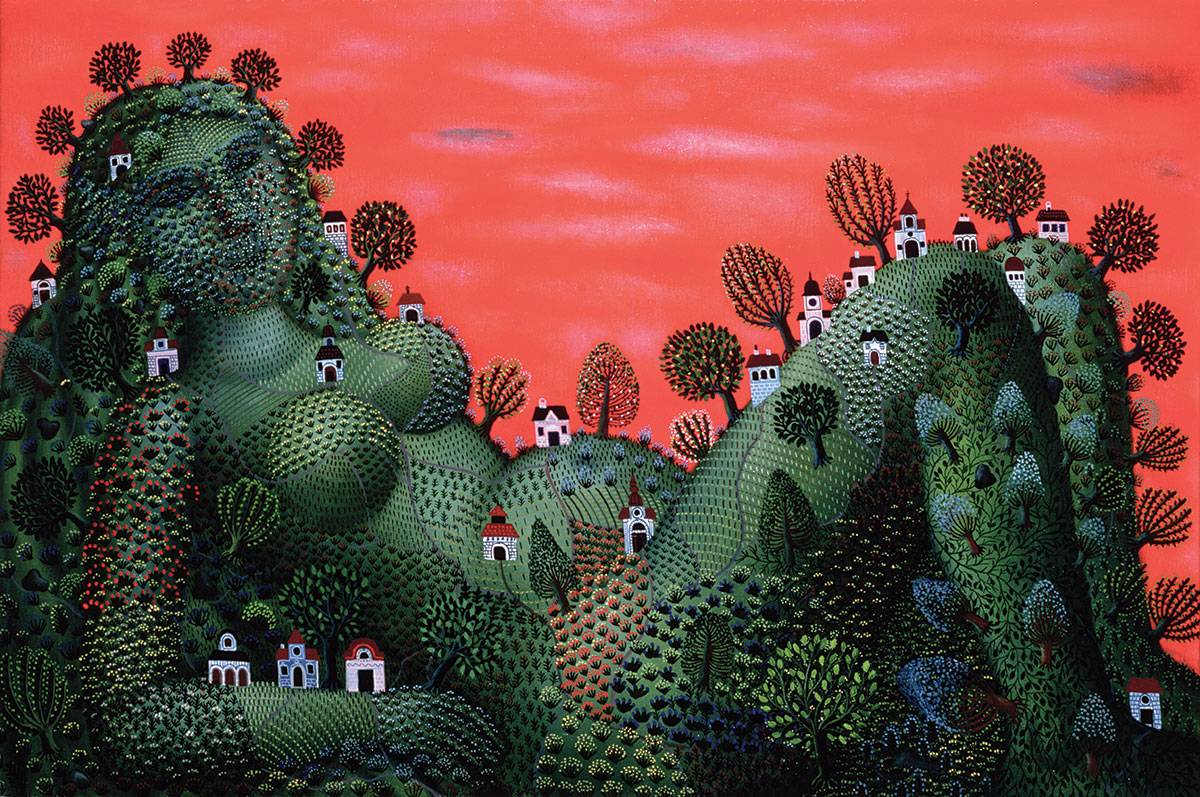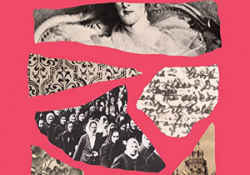Heavens on Earth (an excerpt)

In Heavens on Earth, Carmen Boullosa imagines a postapocalyptic world where spoken and written language is banned, memories are obliterated, and history is erased. The novel is narrated through the voices of three translators—Hernando de Rivas, Estela Ruiz, and Lear—who live in three different eras. Narrating from colonial Mexico, Hernando begins to write the history of El Colegio de la Santa Cruz de Tlatelolco in Latin. Five hundred years later, Estela is given Hernando’s recently discovered manuscript and begins to translate it into Spanish, interweaving vignettes from her own life, family lore, and Mexican history into alternating sections of her translation. In the fragment presented here, Estela recalls her teenage years in the early 1970s when she and her friends were embracing new ideas about sexual liberation and civil rights and rebelling against what they considered to be repressive, traditional Catholic values.
As teenagers during the first two years of the heavenly seventies, we dreamt of sexual equality; we believed in the Cuban dream; we scribbled slogans against racism, our unconditional adoration for Martin Luther King, and abhorrence of the KKK on our school notebooks; and we wore scandalous miniskirts and took the contraceptive pill. The Indians were present for us at that time because their arts and crafts became part of our world, dressing us and adorning our rooms. We wore Oaxacan blouses from various regions, fabulous clothing embroidered in Chiapas, and necklaces and other things that our grandmas (and our moms who were devotees of Chanel, if their pocketbooks allowed) would never have imagined could have been worn by young ladies of our social class. Instead of high-heeled shoes, it was more chic to wear plastic-soled huaraches (which were almost as uncomfortable as those spiked heels, for sure), and we were even brazen enough to wear the bright taffeta of the Mazahuan Indians instead of silk blouses. But the “Indian issue” wasn’t a real concern, or at least not like the “Black issue” was—it was “Black is beautiful,” but not “Lo indio es lo bello.”
A lot of embroidered blouses, a lot of dreams of sexual liberation, much reading of One Hundred Years of Solitude (which was the bible of our generation and a supreme outrage for our fathers), much Angela Davis, and much Susan Sontag, and even more of the Boom—the Donoso Era, the Puig Era, the Fuentes Era . . . But I’ll back up. I was fifteen when I read One Hundred Years of Solitude in my school for young ladies from good families run by the Ursuline nuns. This was when and where the unholy airs began to blow, before the outbreak of the storm that brought the Jesuits and the Cuban dream, and that led to the unveiling of more than one nun and the drawing of more than one student off to incredible adventures . . . My best friend ended up as a guerrilla fighter in two different countries and two different wars before death took her from us forever, not to mention the adventures of other friends and those who went to live in the Colonia Martín Carrera (whose name we heard for the first time around then), or who spent some time with the Tarahumara Indians . . . One Hundred Years of Solitude—the fabric of the dreams of my generation—was part of this breath of fresh air, of these winds. I remember that a month before we read One Hundred Years, they forced Juan Rulfo’s Pedro Páramo on us. I didn’t dislike it, but I don’t think I completely understood the power of the text (I did recognize the power of the printed word, but I wasn’t captivated by the small-mindedness of the catchphrases). I saw in it the image of the parochial Catholic world whose sickly light made me nauseous. Little Pedrito Páramo sitting there by himself in the privy dreaming about Susana San Juan, hearing his mother’s warnings: “A snake’s going to bite you”; “It’s dangerous to spend so much time on the toilet”—it seemed to me that he was the pet victim of Marian devotion. The mother, the grandmother, and the prayers built walls around the boy to protect him from his own body, from the development of his sexual, adult body. As I’ve said, the miniskirt and the pill had arrived and we moved away from the veils and the mantillas that we wore to mass when we were little girls. Pedro Páramo represented a world we despised in our desire for liberation, despite the fact that it certainly represented freedom in literature. One Hundred Years of Solitude was something else. It wasn’t just the way it was written, but rather what it had to say that made it representative (and I would go further and say: a banner) of the death of the repressive and oppressive provincial traditions. The garcíamarquezian province in the liberation of the lópezvelardesque traditions. My reading of One Hundred Years was not a literary reading. I read Pedro Páramo, but One Hundred Years was inscribed on our skin. It’s not that García Márquez wasn’t a real writer, his novel No One Writes to the Colonel was a book. But One Hundred Years of Solitude was the intimate wear and fancy carnival costume we wore to combat the Virgin Mary who we were afraid was trying to turn us into prudes. And at the same time, it was a chronicle and a condemnation, as well as a celebration, of an unusual freedom in tradition-bound Mexico. The south also brought us fresh, liberating air. Angela Davis was not the only one who opened the door to women without mantillas and shawls; García Márquez’s characters—lusty, naked, sensual—did as well.
We read the book in 1970, and we were unrestrainedly enthusiastic. Our fathers scheduled a special meeting to complain about the selection of school material because, in their opinion, that book should not be read by young girls from good families. And why the scandal, if the Mexican bourgeoisie tended to simply ignore books? Why did they place so much “importance” on one book? As part of our schoolwork for our reading of One Hundred Years of Solitude, we made a fun little Super 8 film that was the last straw for our fathers. It got all kinds of reactions. One father (a lawyer with Woodrich Euzkadi in México, if I remember correctly)—undoubtedly a “sleight-of-hand lawyer,” like the ones in Macondo who demonstrated “that the demands lacked all validity” and proclaimed that “the workers did not exist”—invited us to his library to watch a professionally made film of him shooting a white bear (the same one he kept stuffed in his studio). “This is what is important,” he told us. “You all are wasting your time.” His lecture was really more like a conversation among the deaf, because I never got the connection between our Super 8 of One Hundred Years and the film of him shooting the bear. (Of course, our little film participated in the same conversation among the deaf in that it didn’t have anything to do with the novel either because it was basically a sequence of completely random “illustrations” of some brief passages of the novel.)
What was there in One Hundred Years of Solitude that made the hair of “good manners,” of the “establishment,” stand on end? The death of Rulfo’s ghosts, dead through bodily desertion, prayers, and scolding? The anger of the Fernanda del Carpios (“I married a sister of charity”). Were they offended? “Thifisif . . . isfisif onefos ofosif thofosif whosufu cantantant statantand thefesef smufumellu ofosif therisir owfisown shifisifit.” The Fernanda del Carpios and the sleight-of-hand lawyers were not so wrong to be afraid of One Hundred Years of Solitude, given that it was inseparable from the dreams of my generation.
The world—as written in One Hundred Years of Solitude—was reborn for us. This was the new Caribbean and Latin American genesis, rewritten by García Márquez.
What scared the Fernanda del Carpios, the “goddaughters of the Duque of Alba”? (“A lady of such lineage that she made the liver of presidents’ wives quiver, a noble dame of fine blood like her, who had the right to sign eleven peninsular names . . . a lady in a palace or a pigsty, at the table or in bed, a lady of breeding, God-fearing, obeying His laws and submissive to His wishes . . .”)What scared them? The portrayal of antilópezvelardianism? The antirulfo-Sanmatean world, the lusty flesh “shamelessly” depicted in Macondo?
The world—as written in One Hundred Years of Solitude—was reborn for us. This was the new Caribbean and Latin American genesis, rewritten by García Márquez. In rewriting it, he improved it: evil was put in its place, in its proper place, and not in the flesh, not in the body, which occurred very biblically in Pedro Páramo. Evil is not the snake that will appear in the bathroom, called by desire; instead it appears when a Buendía has public funds at his disposal: yes—that will be the shame of the family.
In One Hundred Years of Solitude, woman does not come from the rib of man, but neither does Fuensanta.
History can be rewritten, roles can change significance, and gypsies can become honest because reality is magnificent in and of itself, because we are reborn in the young patriarch, José Arcadio Buendía, who ensures the progress of community; because our countries are not ruled by Pedro Páramos. One Hundred Years of Solitude is the jubilant acceptance that reality is magical, that the power of the imagination creates realities. The novel is filled with an incomparable energy and a promise of the possibility of happiness: the supernatural powers of science and observation. If Melquíades’s gums can “magically” be filled with teeth, then there was hope for reality. One Hundred Years writes the past as a utopia, it rewrites our past because Latin America dreamed of following the Cuban model and “modernizing” through a socialist revolution. The Cuban dream that preceded the Cuban failure. Macondo is “a happy village” that one reaches by following the song of birds. Macondo is José Arcadio Buendía’s dream. He founds utopia by heading “toward the land that no one had promised them.” My generation witnessed the birth of a New Adam, a New Eve, and a New Paradise. Adam is the one who eats of the apple (of knowledge). But the word is so powerful that it destroys him. The anecdotal lust in One Hundred Years of Solitude is shocking. There is so much narrative embroidery, such a compulsion to tell a story that it seems to be an irrational yearning, the author seems to be fleeing from silence, the silence of the dead (“There haven’t been any dead here”)—he has to denounce them in order not to become a cadaver himself. It is with this lustiness that the world reinvents itself and with which, in its haste, also seems to destroy itself. Its anecdotal lust, its cornucopia of anecdotes, doesn’t protect Macondo from destruction. Eden falls. Everything seems to have been written already, and everything is condemned in the end. The liberals, creators of nonsense when it seems that they are winning the war against the conservatives, are “advancing in the opposite direction from reality,” just like the Cuban dream.
Angela Davis was not the only one who opened the door to women without mantillas and shawls; García Márquez’s characters—lusty, naked, sensual—did as well.
“Look what we’ve come to,” Eva-Úrsula said to José Arcadio-Adán. “Look at the empty house, our children scattered all over the world, and the two of us alone again, the same as in the beginning.” Why does the Dream of Dreams die from the very beginning? What does One Hundred Years of Solitude strangle itself with? Sure, they can say I pull everything into my own wheelhouse, that I don’t know the true measure, and that I see everything colored by my own obsessions, but what strikes me is that the Indians are not “actors” in the garcíamarquezian Eden, in this re-creation of reality. The great-great-grandson of the criollo marries the great-great-granddaughter of the Aragonese to found the Buendía lineage. The Indians don’t participate in the re-creation of the world: they don’t achieve legitimacy despite the many anecdotes, all that happens, and everything that spills out of that magic horn from which stories endlessly flow. And, as I said, we collaborated with García Márquez in this sin. We’ve paid dearly. We preserved the colonial and colonialist structure, we lost our own power in all the stories and so much history, and we have relegated ourselves to silence, and into the worst kind of silence, the kind that reeks even worse than dead bodies: the resounding silence of the death of the Dream. One Hundred Years of Solitude, our banner, was the first and the last of this kind of narrative. It redesigned our past, but it strangled our future. In its irrational, compulsive, unhealthy desire to narrate events, Macondo fails in miraculous prosperity and García Márquez redesigns the past and has the power to look into the future. García Márquez is the beginning and ending of the Macondian narrative. He sings the praises of the imagination but closes with a saturation of anecdotes. The world of Pedro Páramo was a world we wanted to lose. One Hundred Years of Solitude was a profession of faith for my generation and a surprise in its premonitory and utopian qualities. But we didn’t realize that we swallowed our own poison along with our banner. Many dreams died along with the big Dream; there is no utopia now. AIDS and disillusionment are here.
I’m not going to tell any more of my own story. I’m going to satisfy myself with the fragments of Hernando’s story. I feel guilty, especially given my present reality. I feel guilty because I sinned in my dreams. Neither I, nor my generation, dreamt of anything that would erase the suicidal structure of our colonial past. So, I’ll make amends for my shame in the best way I can: I’ll dedicate myself and work hard to translate the text of an Indian from the Latin into Spanish, a text that should really be translated into Nahuatl if it was taught in school. We didn’t get that lesson because we were content with dressing in Indian clothing and admiring their traditional arts and crafts. I would even say that, huaraches on the ground, we became more blind, more deaf, more guilty. I don’t deserve to be heard. The author of One Hundred Years of Solitude had the right to the word because he spoke for thousands of dead bodies; moreover, he was a writer—that was his job. I’ll keep quiet. I’m not a writer, and we, my generation and I, didn’t earn the right to talk. I’ll continue with my translation of Hernando; the most I’ll dare to do is to repair what is illegible in the original and lie a little here and there to make his story more plausible.
Translation from the Spanish
By Shelby Vincent
Translator’s note: Boullosa frequently quotes directly from, or refers to, Gabriel García Márquez’s Cien años de soledad (1974). For all the quotations Boullosa takes from Cien años, I have used Gregory Rabassa’s translation, One Hundred Years of Solitude (2006).















